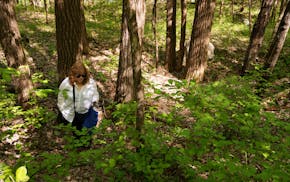The showy lady's slipper may be Minnesota's state flower, but it's one that many residents have probably never seen in the wild.
Soon, it will be time to keep a lookout.
Protected by state law since 1925, the elusive orchids favor moist soil along riverbanks and shorelines, boggy areas and roadside ditches. That also makes them vulnerable to flooding and drainage, road expansions and development, herbicides and pollution, poaching by humans and consumption by deer.
Adding to those challenges, a showy lady's slipper plant may take 15 years or more to flower for the first time. As if to make up for the slow flowering, the plant can produce a half-million seeds as fine as flour dust. Some plants may live to be a century old, according to the Minnesota Department of Natural Resources.
The window to see them is coming quickly — usually the second and third week of June. Earlier varieties such as pink lady's slipper (darker and smaller than the showy ones) and yellow lady's slipper began blooming in the southern half of the state in mid-May.
You can see a variety of orchids and the showy lady's slippers at Eloise Butler Wildflower Garden in Minneapolis and the University of Minnesota Arboretum (southwest end of the Green Heron Bog Boardwalk and in the Dayton Wildflower Garden) in the west metro area.
Showy lady's slippers also can be seen in the wild along the Lake Wobegon Trail between St. Joseph and Avon, along Lake Bemidji State Park's bog walk, and along the Lady Slipper Scenic Byway, which stretches north from Cass Lake to Blackduck through the Chippewa National Forest.
Their scientific name, Cypripedium reginae, comes from the Greek word for "Venus' shoes" (cypripedium) and Latin word for "queen" (reginae). They rule as Minnesota's largest and most vibrant orchids, in showy pink and white, but they're only one of more than 40 native orchid species in Minnesota. That's nearly a quarter of all U.S. orchid species, according to the University of Minnesota Arboretum.
At least 10 of Minnesota's native species are listed as endangered, threatened or a species of special concern, including the dark pink ram's head lady's slipper, the small white lady's slipper and the western prairie fringed orchid. The latter two once thrived on western and southern Minnesota's native prairies.
Other stand-out orchids in Minnesota include the dragon's mouth and purple fringed orchid.
Lisa Meyers McClintick has freelanced for the Minnesota Star Tribune since 2001 and volunteers as a Minnesota Master Naturalist.
Where to find Minnesota's elusive state flower, the showy lady's slipper

Twin Cities musician Jeremy Messersmith finds music in the rhythm of hikes
Canoe, kayak and paddleboard: Your ultimate guide to paddling in the Twin Cities

